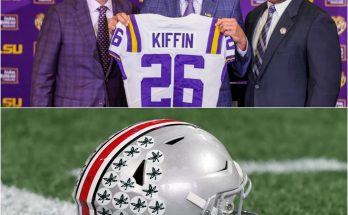There’s a particular electricity that courses through a stadium when the opening chords of “Believer” thunder through the speakers. It’s not just a song—it’s a statement, a moment that unites tens of thousands of voices into one. Behind that moment stands Dan Reynolds, the heartbeat and frontman of Imagine Dragons, a man who has not only defined the band’s anthemic sound but also reshaped modern rock into a global language of resilience, emotion, and identity.
Dan Reynolds didn’t set out to become the architect of stadium anthems. When Imagine Dragons first formed in Las Vegas in 2008, their goal was simple: to create honest, powerful music that resonated with people who felt different. Reynolds, a former Mormon missionary and a student of psychology, brought an introspective depth to the band’s songwriting. But he also possessed something rare—an understanding of how to translate personal pain into communal catharsis. That fusion of vulnerability and might would soon become the defining signature of Imagine Dragons’ sound.
From the beginning, Reynolds stood apart from the typical rock archetype. He was not a swaggering frontman drenched in rebellion or nihilism. Instead, he was reflective, sometimes tormented, but always passionate. His lyrics didn’t revolve around excess or escapism; they were about survival, perseverance, and self-discovery. “It’s Time,” the breakout hit that first put Imagine Dragons on the global map, captured that philosophy perfectly—an anthem of staying true to oneself in the face of change. It wasn’t about tearing down the world but learning to stand tall within it. That sincerity connected deeply with audiences searching for meaning in an increasingly chaotic era.
When “Radioactive” exploded in 2012, Imagine Dragons transcended alternative rock and entered the mainstream stratosphere. The song’s gritty electronic textures, thunderous percussion, and Reynolds’ raw, raspy delivery heralded a new era for rock music. It was apocalyptic yet empowering, mysterious yet relatable. Critics called it genre-bending; fans called it revolutionary. And at the core of that success was Reynolds’ creative vision—to blend the intensity of rock with the accessibility of pop and the emotional immediacy of confession.
Dan Reynolds didn’t just write songs; he constructed experiences. Every track he envisioned was designed not merely for radio play but for the live arena—for the moment when thousands of fans could feel the bass in their chests and scream the lyrics as one. His understanding of dynamics, pacing, and crowd psychology turned Imagine Dragons’ concerts into near-spiritual events. Songs like “Demons,” “Thunder,” and “Whatever It Takes” became communal rituals, where audience and artist fused into something larger than either side alone.
What sets Reynolds apart from many of his contemporaries is his complete rejection of pretense. He has been unflinchingly open about his struggles with depression, anxiety, and physical health issues. In an industry that often masks vulnerability behind glamour, Reynolds did the opposite. He tore down the walls, showing that pain can coexist with power, and that fragility is not weakness but proof of humanity. That authenticity fueled Imagine Dragons’ global appeal. Fans across continents saw in Reynolds not just a rock star, but a mirror—a reminder that their stories, too, deserved to be sung aloud.
As Imagine Dragons grew into one of the world’s biggest bands, their sound evolved, but Reynolds’ fingerprints remained unmistakable. He guided the band through every stylistic shift, from the atmospheric melancholy of Smoke + Mirrors to the euphoric energy of Evolve and the introspective storytelling of Mercury. Each album was a reflection of a man unafraid to experiment, to fail, to feel. Even when critics dismissed their bombastic style as formulaic, Reynolds stood firm. To him, the point was never to please purists—it was to connect with people. And the numbers spoke louder than any review: billions of streams, sold-out arenas, and anthems that became embedded in pop culture.
Beyond music, Reynolds became an advocate, a voice for causes far beyond the stage. His work with the LOVELOUD Foundation—an organization he founded to support and affirm LGBTQ+ youth—cemented his legacy not just as a musician, but as a humanitarian. Having grown up within the conservative confines of the Mormon Church, Reynolds understood firsthand the weight of exclusion. Instead of turning away, he chose to build bridges. Through LOVELOUD, he brought thousands together under a message of acceptance and compassion, using his platform to challenge cultural norms and encourage dialogue. That courage to confront discomfort became as integral to his identity as any lyric he ever wrote.
Reynolds’ artistry thrives on dualities: strength and sensitivity, triumph and pain, light and shadow. It’s that complexity that gives Imagine Dragons’ music its universal pull. In an era dominated by fleeting trends and algorithm-driven hits, the band’s songs endure because they touch something primal. When Reynolds belts out, “Pain! You made me a, you made me a believer,” it’s not just performance—it’s testimony. The emotion is real, the conviction undeniable. He doesn’t perform for the audience; he performs with them, as if each lyric is a shared confession.
Perhaps the most fascinating aspect of Reynolds’ journey is how he redefined what it means to be a frontman in the modern age. While past icons built mystique through distance, Reynolds built intimacy through openness. He speaks candidly about therapy, faith, marriage, fatherhood, and failure. He dismantles the illusion of perfection, allowing fans to see the human behind the hits. That honesty has not only kept Imagine Dragons relevant but also made them a cultural force of empathy in a time of division.
In the process, Reynolds turned Imagine Dragons into something more than a band. They became a soundtrack for perseverance—a beacon for anyone fighting unseen battles. Stadiums filled with fans from every generation and background chant lyrics not just because they sound good, but because they feel true. Each song is a lifeline, a reminder that pain can forge purpose, and that music can be both therapy and triumph.
Reynolds’ creative process is deeply intuitive. He often describes songwriting as an act of emotional excavation—digging through his subconscious until he uncovers something real enough to hurt. That willingness to bleed on the page is what transforms a melody into an anthem. He’s said that he writes for the person he was at his lowest—the kid who felt isolated, misunderstood, and afraid. In doing so, he gives voice to millions who have felt the same.
Yet, despite the global success, Reynolds remains restless. He’s an artist perpetually chasing evolution. Whether it’s experimenting with electronic soundscapes or exploring acoustic vulnerability, he refuses to stagnate. Each era of Imagine Dragons feels like a new chapter in his ongoing dialogue with the world—and with himself. There’s a fearless curiosity in his approach, a refusal to be boxed in by genre or expectation.



